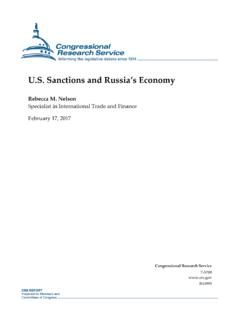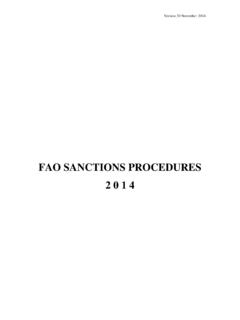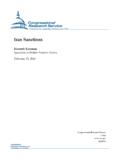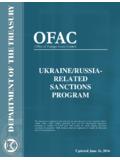Transcription of Effective screening Controls for sanctions and AML …
1 Effective screening Controls for sanctions and AML risk managementEffective screening Controls for sanctions and AML risk managementRecent record fines for sanctions breaches and failure to identify Politically Exposed Persons (PEPs) have led to closer scrutiny of screening Controls . But rather than effectively mitigating the risks, a common approach is simply to drop thresholds and augment the workforce. While these actions may be required to some extent, a more measured approach will help to control costs while also addressing gaps in existing programs continue to follow industry trends often mistaken to be best practice rather than fully understanding the risks and responding with a proportionate control framework.
2 Such a framework is likely to be achieved by instead cutting watch-lists and focusing on areas of risk previously overlooked. Over- screening is prevalent, with watch-lists including targets from distant sanctions regimes and PEPs who are not really PEPs at all. Meanwhile, financial institutions (FIs) tend not to screen domestic transactions due to a tacit agreement across the industry to rely upon each other s customer screening Controls . And, although systems are in place to monitor the money laundering risk associated with transactional behavior, no such Controls are in place to evaluate the money laundering risk of transactions from the perspective of who they advanced sanctions prevention and Anti-Money Laundering (AML) screening program would consider:1.
3 Tailoring the content and application of watch-lists to the organization s risk profile and appetite significant operational cost savings can be made by streamlining watch lists in the following ways: Identifying a core set of sanctions lists to use for all customer relationships and transactions, and only utilizing lists belonging to other regimes where particular scenarios ( , destination of a transaction) dictate that this is necessary Determining the organization s definition of a PEP upfront ( , based on public office held, country of office, relationship with the primary PEP, etc.) and tailoring PEP lists accordingly Avoiding duplication across screening Controls , FIs may determine that it is not necessary to re-screen their own customers in transactions when they have already been screened against the relevant lists2.
4 screening unconventional but known areas of sanctions and money laundering risk real risks are present in some previously overlooked areas: In domestic transactions involving sanctions targets relying on the customer screening Controls of other domestic institutions could lead to a breach occurring Where individuals and organizations that pose a high risk of money laundering ( , PEPs) are transacting with the organization s customers; it is likely many transactions involving such targets should give rise to suspicion of money laundering activity12 Effective screening Controls for sanctions and AML risk managementThere is no obligation to screen customers or transactions.
5 It is recommended by the Joint Money Laundering Steering Group (JMLSG)1 as a practical method for identifying sanctions targets but it is a means, not an end. FIs must be careful that they do not lose sight of the objectives they are attempting to meet with their screening program. There are at least four objectives which screening may be used to help address:1. sanctions : To not permit financial transactions with sanctions targets2. Enhanced Due Diligence (EDD): To undertake EDD on PEPs and other high risk customers3. Suspicious activity: To identify suspicious activity that may be indicative of money laundering4.
6 Negative news: To undertake negative news searches as a part of EDD on PEPs and high-risk customersThe disparate range of objectives may, in itself, shed some light on the sometimes conflicting priorities in screening programs. For each objective, there is a need to accurately identify an individual or organization (a target ) in order that some other action can be taken, whether it be stopping a transaction or identifying the need to undertake additional due diligence. It may be argued that the Suspicious Activity objective is more relevant to an AML transaction monitoring program than a screening program.
7 However, its relevance here is in relation to the fact that transactions can be suspicious in virtue of the counterparties they involve, not just the behavior which they screening programs implement at least two main screening Controls to help meet these objectives: customer screening and transaction screening . Customer screening is used to identify new or existing customer relationships which may involve targets of interest; transaction screening is used to identify transactions involving such targets. Together, customer and transaction screening are intended to form a complete set of automated2 screening Controls for identifying sanctions , PEPs and other high risk targets entering the organization or having financial dealings with it.
8 However, there are a number of limitations in the way in which these Controls are implemented, often resulting in risks not being effectively managed and significant inefficiencies being introduced into the screening JMLSG Part III (Note: As stated by JMLSG, the guidance in Part III does not carry the same Ministerial approval as the guidance in Parts I and II. )2 Additional manual Controls are often in place , use of Customer Due Diligence (CDD) processes to identify PEPsThe purpose of screening3 Effective screening Controls for sanctions and AML risk managementThe following diagram represents the interactions a typical FI may have which will expose it to high risk individuals and organizations.
9 These interactions include starting a new customer relationship, continuing an existing customer relationship and transacting with other organizations (including an organization s own affiliates). It also highlights the points at which customers or transactions may be screened during the different interactions and the types of lists that they may be screened organizationLists:KeyOther organizationsDomesticSanctionsAMLA dverse mediaInternational12345 IndividualOrganizationTransactionHigh riskMedium riskLow riskScreeningScreening (potential)Unknown riskPotential gaps and inefficiencies in screening Controls 4 Effective screening Controls for sanctions and AML risk managementThe different points at which screening might be undertaken are enumerated in the following table, along with some observations and potential areas of gap?
10 Potential over- screening ?1 New customers New customers are screened against sanctions and AML lists New customers are only screened against negative news if the customer is high riskNoYes: Targets which pose a low risk of money laundering Extraneous sanctions entries2 Existing customers Existing customers are screened against sanctions and AML ( , PEP) lists when either the customer record changes or the list changes (and sometimes also during a periodic review) Existing customers are only screened against negative news if the customer is high riskNoYes: Targets which pose a low risk of money laundering Extraneous sanctions entries 3 All transactions (with other organizations, including affiliates) Counterparties are rarely screened against AML listsYes: Counterparties which may pose a money laundering risk are not screenedNo4 Domestic transactions (including Single Euro Payments Area [SEPA] transactions in the Eurozone) Counterparties in domestic transactions are not screened against any listsYes.

















